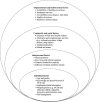Preference and willingness to receive non-communicable disease services from primary healthcare facilities in Bangladesh: A qualitative study
- PMID: 36463166
- PMCID: PMC9719224
- DOI: 10.1186/s12913-022-08886-3
Preference and willingness to receive non-communicable disease services from primary healthcare facilities in Bangladesh: A qualitative study
Abstract
Background: In Bangladesh, non-communicable diseases (NCDs) are increasing rapidly and account for approximately 68% of mortality and 64% of disease burden. NCD services have been significantly mobilized to primary healthcare (PHC) facilities to better manage the rising burden of NCDs. However, little is known about community members' preference and willingness to receive NCD services from PHC facilities; therefore, this particular subject is the focus of this study.
Methods: A qualitative study was conducted from May 2021 to October 2021. Data were collected via 16 focus group discussions involving community members and 14 key informant interviews with healthcare professionals, facility managers, and public health practitioners. Based on a social-ecological model (SEM), data were analyzed thematically. The triangulation of methods and participants was conducted to validate the information provided.
Results: Preference and willingness to receive NCD services from PHC facilities were influenced by a range of individual, interpersonal, societal, and organizational factors that were interconnected and influenced each other. Knowledge and the perceived need for NCD care, misperception, self-management, interpersonal, and family-level factors played important roles in using PHC facilities. Community and societal factors (i.e., the availability of alternative and complementary services, traditional practices, social norms) and organizational and health system factors (i.e., a shortage of medicines, diagnostic capacity, untrained human resources, and poor quality of care) also emerged as key aspects that influenced preference and willingness to receive NCD services from PHC facilities.
Conclusion: Despite their substantial potential, PHC facilities may not take full advantage of managing NCDs. All four factors need to be considered when developing NCD service interventions in the primary healthcare system to better address the rising burden of NCDs.
Keywords: Non-communicable diseases; Preference and willingness; Primary healthcare facilities; Social-ecological model.
© 2022. The Author(s).
Conflict of interest statement
The authors declare that they have no competing interests.
Figures
Similar articles
-
The capacity of primary healthcare facilities in Bangladesh to prevent and control non-communicable diseases.BMC Prim Care. 2023 Mar 2;24(1):60. doi: 10.1186/s12875-023-02016-6. BMC Prim Care. 2023. PMID: 36864391 Free PMC article.
-
Health system challenges and opportunities in organizing non-communicable diseases services delivery at primary healthcare level in Bangladesh: A qualitative study.Front Public Health. 2022 Nov 9;10:1015245. doi: 10.3389/fpubh.2022.1015245. eCollection 2022. Front Public Health. 2022. PMID: 36438215 Free PMC article.
-
Non-communicable disease (NCD) corners in public sector health facilities in Bangladesh: a qualitative study assessing challenges and opportunities for improving NCD services at the primary healthcare level.BMJ Open. 2019 Oct 7;9(10):e029562. doi: 10.1136/bmjopen-2019-029562. BMJ Open. 2019. PMID: 31594874 Free PMC article.
-
How well are non-communicable disease services being integrated into primary health care in Africa: A review of progress against World Health Organization's African regional targets.PLoS One. 2020 Oct 22;15(10):e0240984. doi: 10.1371/journal.pone.0240984. eCollection 2020. PLoS One. 2020. PMID: 33091037 Free PMC article. Review.
-
Delivering non-communicable disease services through primary health care in selected south Asian countries: are health systems prepared?Lancet Glob Health. 2024 Oct;12(10):e1706-e1719. doi: 10.1016/S2214-109X(24)00118-9. Epub 2024 Aug 20. Lancet Glob Health. 2024. PMID: 39178879 Free PMC article. Review.
Cited by
-
Exploring type 2 diabetes self-management practices in rural Bangladesh: facilitators, barriers and expectations-a qualitative study protocol.BMJ Open. 2024 May 2;14(5):e081385. doi: 10.1136/bmjopen-2023-081385. BMJ Open. 2024. PMID: 38697759 Free PMC article.
-
Challenges and Strategies in Conducting Population Health Research during the COVID-19 Pandemic: Experience from a Nationwide Mixed-Methods Study in Bangladesh.Int J Environ Res Public Health. 2023 Apr 25;20(9):5629. doi: 10.3390/ijerph20095629. Int J Environ Res Public Health. 2023. PMID: 37174149 Free PMC article.
-
Prevalence and correlates of health care utilization for non-communicable diseases in Bangladesh.BMC Health Serv Res. 2025 May 21;25(1):736. doi: 10.1186/s12913-025-12906-3. BMC Health Serv Res. 2025. PMID: 40400010 Free PMC article.
-
Disparities and factors affecting hypertension diagnosis from qualified doctors in Bangladesh and its impact on receiving hypertension control advice: Analysis of demographic & health survey 2017-18.PLOS Glob Public Health. 2024 Jul 23;4(7):e0003496. doi: 10.1371/journal.pgph.0003496. eCollection 2024. PLOS Glob Public Health. 2024. PMID: 39042619 Free PMC article.
-
The capacity of primary healthcare facilities in Bangladesh to prevent and control non-communicable diseases.BMC Prim Care. 2023 Mar 2;24(1):60. doi: 10.1186/s12875-023-02016-6. BMC Prim Care. 2023. PMID: 36864391 Free PMC article.
References
-
- World Health Organization. Noncommunicable diseases: Key facts. WHO. 2018; Available from: https://www.who.int/news-room/fact-sheets/detail/noncommunicable-diseases.
-
- World Health Organization. Bangladesh: World Health Organization; [cited 2020 August 13] Available from: https://www.who.int/workforcealliance/countries/bgd/en/.
-
- Ahmed SM. Non-communicable Diseases in Bangladesh: Current Scenario and Future Directions: Bangladesh Health Watch Secretariat. James P Grant School of Public Health …; 2017.
MeSH terms
LinkOut - more resources
Full Text Sources


